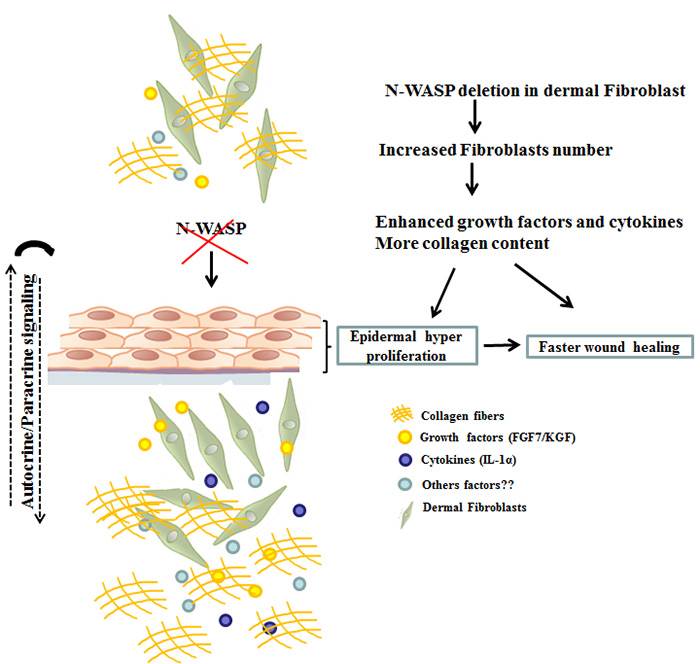Cancer Cell Biology

DESCRIPTION OF LAB RESEARCH WORK
My laboratory is interested in
characterizing the role of N-WASP (Neural Wiskott Aldrich Syndrome
Protein) in cellular processes such as cell proliferation and migration,
processes which play a critical role in Metastasis. N-WASP is an
ubiquitously expressed adaptor protein which regulates actin
cytoskeleton by activating of the Arp2/3 complex. Expression of N-WASP
has been found to be reduced in a number of cancers and increased in
other cancers. Our working hypothesis is that N-WASP is a tumor
suppressor in early stage cancer and a tumor promoter in late stage
cancer. In order to characterize the in-vivo role of N-WASP in various
cellular processes we have generate N-WASPfloxed mice. Using this mice
and appropriate Cre expressing mice we have characterized the role of
N-WASP in fibroblast and Keratinocytes. We are presently characterizing
the role of N-WASP in tumorigenesis, epithelial-to-mesenchymal
transition, metastasis and wound healing.
LAB MEMBERS
 | LEAD PI
Thirumaran Thanabalu Associate Professor Email: thirumaran@ntu.edu.sg Office: SBS-01N-09/03N-17 |
 | Myra Alnawaz
Research Assistant Email: myra.alnawaz@ntu.edu.sg |
 | Apoorva Verma
PhD Student Email: apoorva001@e.ntu.edu.sg |
 | Lee Ying Hui PhD Student Email: yinghui001@e.ntu.edu.sg |
CURRENT PROJECTS
- Role of N-WASP in Mammary Gland development simulation
- Role of N-WASP in Lung Development
- Use of functional food and Traditional Chinese Medicine in Atopic Dermatitis
- Identification of small molecule N-WASP inhibitors
PUBLICATIONS
- Phua SZF, Yang G, Lim WQ, Verma A, Chen H, Thanabalu T, Zhao Y. (2019) Catalase-Integrated Hyaluronic Acid as Nanocarriers for Enhanced Photodynamic Therapy in Solid Tumor. ACS Nano. 13(4):4742-4751.
- Kalailingam P, Tan HB, Pan JY, Tan SH, Thanabalu T. (2019) Overexpression of CDC42SE1 in A431 Cells Reduced Cell Proliferation by Inhibiting the Akt Pathway. Cells. 8(2). pii: E117. Feb 2019
- Kalailingam P, Tan HB, Jain N, Sng MK, Chan JSK, Tan NS, Thanabalu T. (2017) Conditional knock out of N-WASP in keratinocytes causes skin barrier defects and atopic dermatitis-like inflammation. Sci Rep. 7(1):7311. Aug 2017 IF 4.609
- Mitra P, Thanabalu T. (2017) Myogenic differentiation depends on the interplay of Grb2 and N-WASP. Biochim Biophys Acta (BBA) Molecular Cell Research. 1864(3):487-497
- Jain N, Kalailingam P, Tan KW, Tan HB, Sng MK, Chan JSK, Tan NS and T Thanabalu (2016) Conditional knockout of N-WASP in mouse fibroblast caused keratinocyte hyper proliferation and enhanced wound closure, Sci Rep. 6:38109.
- Jain N, Thanabalu T. (2015) Molecular difference between WASP and N-WASP critical for chemotaxis of T-cells towards SDF-1α. Sci Rep. 5:15031.
- Li Y, Jain N, Limpanawat S, To J, Quistgaard EM, Nordlund P, Thanabalu T, Torres J. (2015) Interaction between human BAP31 and respiratory syncytial virus small hydrophobic (SH) protein. Virology. 482:105-110.
- George B, Jain N, Fen Chong P, Hou Tan J, Thanabalu T. (2014) Myogenesis defect due to Toca-1 knockdown can be suppressed by expression of N-WASP. Biochim Biophys Acta (BBA) Molecular Cell Research 1843(9):1930-41.
- Jain N, George B, Thanabalu T. (2014) Wiskott-Aldrich Syndrome causing mutation, Pro373Ser restricts conformational changes essential for WASP activity in T-cells. Biochim Biophys Acta. (BBA) Molecular Basis of Disease 1842:623-34.
- Jain N, Lim LW, Tan WT, George B, Makeyev E, Thanabalu T. (2014) Conditional N-WASP knockout in mouse brain implicates actin cytoskeleton regulation in hydrocephalus pathology. Exp Neurol. 254:29-40.

